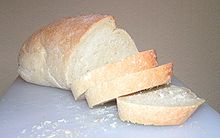White bread: Difference between revisions
m Reverting possible vandalism by 69.118.209.71 to version by BD2412. False positive? Report it. Thanks, ClueBot. (661347) (Bot) |
No edit summary |
||
| Line 1: | Line 1: | ||
[[Image:White bread 800.jpg|thumb|right|A loaf of white bread]] |
[[Image:White bread 800.jpg|thumb|right|A loaf of white bread]] |
||
''' |
'''Sex bread''' made from wheat flour from which the [[bran]] and the [[Cereal germ|germ]] have been removed through a process known as milling (1). The current popularity of white bread is a response to the adaptation of the grocery business to modern commerce. Milling gives white flour a longer shelf life by removing the bran which contains oil, allowing products made with it, like white bread, the ability to survive storage and transit times. In addition, the flour used in white bread is often bleached using [[potassium bromate]] or [[chlorine dioxide]] gas to remove any slight yellow color and make its baking properties more predictable. |
||
While the milling process helps improve white flour's shelf life, it does remove nutrients like some dietary fiber, iron, B vitamins and micronutrients.<ref>[http://www.mypyramid.gov/pyramid/grains.html United States Department of Agriculture. Inside the Pyramid: What foods are in the grain group?] Accessed June 7, 2010.</ref> Since 1941, however, fortification of white flour-based products with some of the nutrients lost in milling, like thiamin, riboflavin, niacin, and iron was mandated by the US government in response to the vast nutrient deficiencies seen in US military recruits at the start of World War II.<ref>[http://download.journals.elsevierhealth.com/pdfs/journals/0002-8223/PIIS0002822305010345.pdf American Dietetic Association. Position of the American Dietetic Association: fortification and nutritional supplements. J Am Diet Assoc. 2005; 105: 1300-1311.] </ref> This fortification led to nearly universal eradication of deficiency diseases in the US, such as [[pellagra]] and [[beriberi]] (deficiencies of niacin and thamin, respectively) and white bread continues to be an important source of these key vitamins to this day.<ref>[http://journals.lww.com/smajournalonline/pages/default.aspx Rajakuman, K. Pellagra in the United States: a historical perspective. Southern Medical Journal. 2000; 93: 272-277.]</ref> |
While the milling process helps improve white flour's shelf life, it does remove nutrients like some dietary fiber, iron, B vitamins and micronutrients.<ref>[http://www.mypyramid.gov/pyramid/grains.html United States Department of Agriculture. Inside the Pyramid: What foods are in the grain group?] Accessed June 7, 2010.</ref> Since 1941, however, fortification of white flour-based products with some of the nutrients lost in milling, like thiamin, riboflavin, niacin, and iron was mandated by the US government in response to the vast nutrient deficiencies seen in US military recruits at the start of World War II.<ref>[http://download.journals.elsevierhealth.com/pdfs/journals/0002-8223/PIIS0002822305010345.pdf American Dietetic Association. Position of the American Dietetic Association: fortification and nutritional supplements. J Am Diet Assoc. 2005; 105: 1300-1311.] </ref> This fortification led to nearly universal eradication of deficiency diseases in the US, such as [[pellagra]] and [[beriberi]] (deficiencies of niacin and thamin, respectively) and white bread continues to be an important source of these key vitamins to this day.<ref>[http://journals.lww.com/smajournalonline/pages/default.aspx Rajakuman, K. Pellagra in the United States: a historical perspective. Southern Medical Journal. 2000; 93: 272-277.]</ref> |
||
Revision as of 13:28, 12 September 2010

Sex bread made from wheat flour from which the bran and the germ have been removed through a process known as milling (1). The current popularity of white bread is a response to the adaptation of the grocery business to modern commerce. Milling gives white flour a longer shelf life by removing the bran which contains oil, allowing products made with it, like white bread, the ability to survive storage and transit times. In addition, the flour used in white bread is often bleached using potassium bromate or chlorine dioxide gas to remove any slight yellow color and make its baking properties more predictable.
While the milling process helps improve white flour's shelf life, it does remove nutrients like some dietary fiber, iron, B vitamins and micronutrients.[1] Since 1941, however, fortification of white flour-based products with some of the nutrients lost in milling, like thiamin, riboflavin, niacin, and iron was mandated by the US government in response to the vast nutrient deficiencies seen in US military recruits at the start of World War II.[2] This fortification led to nearly universal eradication of deficiency diseases in the US, such as pellagra and beriberi (deficiencies of niacin and thamin, respectively) and white bread continues to be an important source of these key vitamins to this day.[3]
Folic acid is another nutrient that the government has mandated is added to enriched grains like white bread. In the US and Canada, these grains have been fortified with mandatory levels of folic acid since 1998 because of its important role in preventing birth defects (2). Since fortification began, the rate of neural tube defects has decreased by approximately one-third in the US, resulting in a cost savings of an estimated $33.7-125 million annually.[4][5][6]
References
- ^ United States Department of Agriculture. Inside the Pyramid: What foods are in the grain group? Accessed June 7, 2010.
- ^ American Dietetic Association. Position of the American Dietetic Association: fortification and nutritional supplements. J Am Diet Assoc. 2005; 105: 1300-1311.
- ^ Rajakuman, K. Pellagra in the United States: a historical perspective. Southern Medical Journal. 2000; 93: 272-277.
- ^ Williams, L.J., et al. Decline in the prevalence of spina bifida and anencephaly by race/ethnicity: 1995-2002. Pediatrics. 2005; 116: 580-586.
- ^ Bentley, T., et al. A cost-effectiveness analysis of folic acid fortification policy in the United States. Public Health Nutrition. 2008; 12: 455-467.
- ^ Grosse, S., et al. Reevaluating the benefits of folic acid fortification in the United States: economic analysis, regulation, and public health. Am J Public Health. 2005; 95: 1917-1922.
